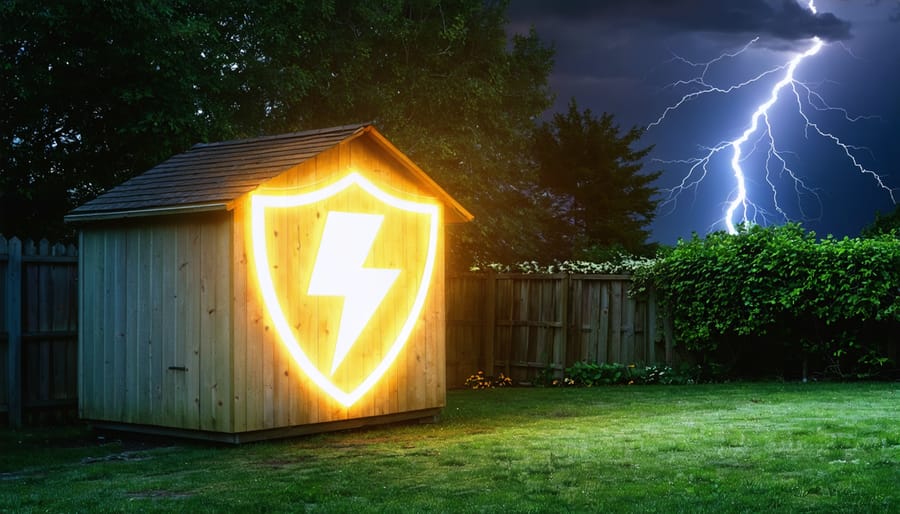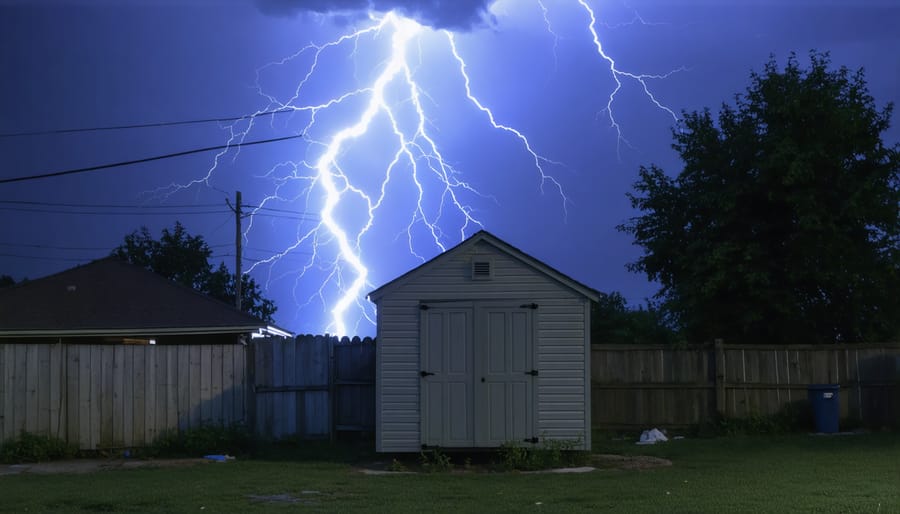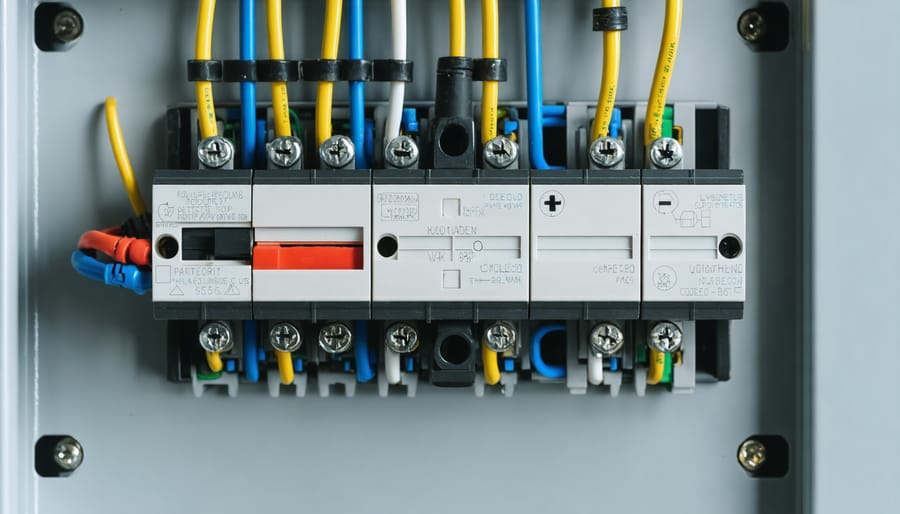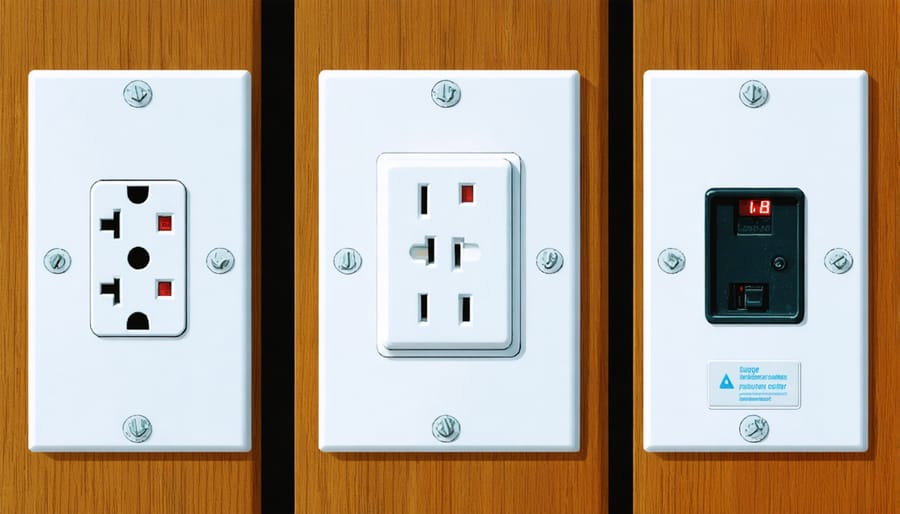Protect Your Shed’s Electrical System from Power Surges (Without Breaking the Bank)

Protect your valuable electronics and shed’s electrical system from devastating power surges with whole-house surge protection installed directly at your electrical panel. Lightning strikes, utility grid fluctuations, and power restoration after outages can send destructive voltage spikes through your wiring, damaging expensive equipment and creating fire hazards. Modern surge protectors mount directly to your main breaker panel, intercepting surges before they enter your home’s circuits, and typically provide up to 40,000 amps of protection. While basic power strips offer some defense, only panel-mounted surge protection delivers comprehensive safeguarding for your entire electrical system. With proper surge protection, you’ll shield sensitive electronics, appliances, and equipment from unexpected power fluctuations that could otherwise result in thousands of dollars in damage and replacement costs.
Why Your Shed’s Electrical Panel Needs Surge Protection

Common Causes of Power Surges in Outdoor Buildings
Outdoor buildings like sheds face unique challenges when it comes to power surges, and understanding these risks is crucial to prevent potential consequences of electrical damage. The most common and dramatic cause is lightning strikes, which can send thousands of volts surging through your shed’s electrical system in a fraction of a second. While direct strikes are rare, even nearby lightning can induce dangerous voltage spikes in your wiring.
Utility grid switching is another frequent source of power surges in outdoor buildings. When power companies switch electrical distributions or restore service after an outage, the resulting surge can affect your shed’s electrical system. These surges might be smaller than lightning strikes but occur more frequently and can cause cumulative damage over time.
Large equipment starting up nearby can also create power fluctuations. If your shed houses power tools or machinery, the sudden demand for electricity when these devices start can create mini-surges that affect other connected equipment. Additionally, downed power lines from storms or accidents can send unexpected voltage spikes through the local grid, putting your shed’s electrical system at risk.
Wildlife interference, such as animals chewing through cables or creating shorts in outdoor electrical equipment, can trigger sudden power surges. The exposed nature of outdoor wiring makes these buildings particularly vulnerable to such incidents.
Types of Surge Protectors for Shed Electrical Panels
Whole-Panel Surge Protectors
Whole-panel surge protectors offer the most comprehensive protection for your electrical panel by guarding all circuits simultaneously. These devices mount directly to your main breaker panel and act as your first line of defense against power surges. Think of them as a shield that protects your entire home’s electrical system from harmful voltage spikes.
Most whole-panel protectors feature indicator lights that show when they’re working properly and alert you if protection has been compromised. Quality models typically offer protection ratings between 40,000 and 140,000 amperes, making them robust enough to handle major surge events from lightning strikes or utility company issues.
Installation requires a licensed electrician, as these devices connect directly to your main panel’s bus bars. While the upfront cost might be higher than plug-in options, whole-panel protection typically proves more cost-effective in the long run by safeguarding all your home’s electrical circuits and connected devices simultaneously. Many insurance companies even offer discounts for homes with properly installed whole-panel surge protection.
Remember to look for UL-listed devices with clear warranty terms for the best protection of your investment.

Branch Circuit Protectors
Individual circuits within your shed deserve dedicated protection to safeguard specific equipment and appliances. Branch circuit protectors act as a second line of defense, working alongside your main panel surge protector to provide comprehensive coverage. These devices are typically installed directly at the circuit breaker or outlet level, offering targeted protection for sensitive equipment like power tools, refrigerators, or workshop machinery.
For optimal protection, consider installing surge protective devices rated for 20-40kA per phase on critical circuits. Look for models with indicator lights that show protection status, so you’ll know when they need replacement. It’s especially important to protect circuits powering expensive tools or equipment with microprocessors, as these are particularly vulnerable to surge damage.
Remember to prioritize circuits based on the equipment they serve. While you might not need surge protection for basic lighting circuits, any circuit powering computers, chargers, or specialized workshop equipment should have dedicated protection. This layered approach ensures your valuable tools and equipment remain safe even if one protective device fails.

Installation Considerations for Shed Surge Protection
When installing surge protection in your shed’s electrical panel, proper placement and installation are crucial for effective protection. Start by choosing weather-resistant electrical components that can withstand outdoor conditions. Position the surge protector as close to the main panel as possible to ensure optimal protection for all downstream circuits.
Before installation, always turn off the main power supply to the shed and use appropriate safety equipment, including insulated gloves and tools. Mount the surge protector in a clean, dry location within the panel, ensuring there’s adequate space for ventilation and future maintenance.
For sheds with sensitive equipment like power tools or workshop machinery, consider installing a secondary point-of-use surge protector for added protection. Make sure all connections are tight and secure, as loose connections can reduce the effectiveness of surge protection and potentially create safety hazards.
Document the installation date and set up a reminder for regular inspections – most surge protectors should be checked annually for signs of wear or damage. Pay special attention to the indicator lights, which show whether the device is functioning correctly.
Remember to verify that your shed’s grounding system is up to code, as proper grounding is essential for surge protection to work effectively. If you’re unsure about any aspect of the installation, don’t hesitate to consult a licensed electrician.
Protecting your home’s electrical system with proper surge protection is an investment that pays dividends in safety and peace of mind. By installing whole-house surge protectors at your electrical panel, you create a robust defense against damaging power surges that could otherwise destroy expensive appliances and electronics. Remember to choose UL-listed devices rated for your specific panel, and consider implementing a multi-layered approach with both panel-mounted and point-of-use surge protectors. While professional installation is recommended, the cost is minimal compared to replacing damaged equipment or dealing with electrical fires. Don’t wait for a catastrophic surge to take action – safeguard your home’s electrical system today with appropriate surge protection measures.

